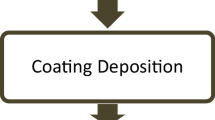Abstract
A novel cerium-tannic acid passivation treatment was performed on galvanized steel. The corrosion resistance of cerium-tannic passivated samples was tested by dropping test with 0.5 wt.% CuSO4 aqueous solution. The mass loss per unit area of passivated samples was measured after the corrosion in 0.5 mol/L NaCl + 0.005 mol/L H2SO4 at room temperature for 96 h. The electrochemical behaviors of cerium, tannic acid, and cerium-tannic acid passivated samples on galvanized steel in 0.5 mol/L NaCl solution were investigated by polarization curves and electrochemical impendence spectra. The corrosion equivalent circuit was established according to the impedance characteristics. The results show that cerium-tannic acid treated samples exhibit better corrosion resistance than the sole cerium or tannic acid treated samples under the same condition. The mechanism of synergistic effect for cerium-tannic acid passivation on galvanized steel was discussed.
Similar content being viewed by others
References
Lunder O., Walmsley J.C., Mack P., and Nisancioglu K., Formation and characterisation of a chromate conversion coating on AA6060 aluminium, Corros. Sci., 2005, 47: 1604.
Hao J.J., An C.Q., and Mou S.H., Advances in research on unchromium passivation of galvanized zinc layer, Mater. Rev., 2003, 9(17): 19.
Tang T. and Beth-Nielsen G., Molybdate-based alternatives to chromating as a passivation treatment for zinc, Plat. Surf. Finish., 1994, 18(11): 20.
Wang D. and Tang X., A study of the film formation kinetics on zinc in different acidic corrosion inhibitor solutions by quartz crystal microbalance, Corros. Sci., 2005, 9(47): 2157.
Bexell U. and Grehk T.M., A corrosion study of hot-dip galvanized steel sheet pre-treated with γ-mercaptopropyltrimethoxysilane, Surf. Coat. Technol., 2007, 201: 4734.
Deflorian F., Rossi S., Fedrizzi L., and Bonora P.L., EIS study of organic coating on zinc surface pretreated with environmentally friendly products, Prog. Org. Coat., 2005, 52: 271.
Aramaki K. The effect of medication with hydrogen peroxide on a hydrated cerium (III) oxide layer for protection of zinc against corrosion in 0.5 M NaCl, Corros. Sci., 2006, 48(16): 766.
Hinton B.R.W. and Wilson L., The corrosion inhibition of zinc with cerous chloride, Corros. Sci., 1989, 29(9): 967.
Roman L., Blidariu M., and Cristescu C., Study of conversion coating on zinc deposition obtained from low pollution solutions, Trans. IMF, 1997, 75: 324.
Hiromasa S. and Masao S., Surface Treated Metallic Materials with Corrosion Resistance and Surface Treatment Used therefore, USA patent, WO 28291, 1996.
Takao O., Surface Treatment Agent for Zinciferous-Plated Steel, USA patent, 5846342, 1998.
Jaen J.A., Arauz E.Y., Iglesias J., and Delgado Y., Reactivity of tannic acid with common corrosion products and its influence on the hydrolysis of iron in alkaline solutions, Hyperfine Interact., 2003, 148/149: 199.
Iglesias J., Saldana E.G.D., and Jaen J.A., On the tannic acid interaction with metallic iron, Hyperfine Interact., 2001, 134: 109.
Al-Mayouf A.M., Inhibitors for chemical cleaning of iron with tannic acid, Desalination, 1999, 121(2): 173.
Mu G.N. and Liu G.H., The synergistic inhibition effect of Y(III) ion and polyethlene glycol mono-(p) octyl phenyl ether (OP) on corrosion of zinc, Corros. Prot. (in Chinese), 2002, 23(2): 51.
Rajendran S., Apparao B.V, and Palaniswamy N., Synergistic and antagonistic effects existing among polyacrylamide phenyl phosphonate and Zn2+ on the inhibition of corrosion of mild steel in a neutral aqueous environment, Electrochem. Acta, 1998, 44: 533.
Yang L., Liu G., Qian Y., and Du N., Electrochemical behavior of the cerium passivating film on galvanized steel, Surf. Technol. (in Chinese), 2006, 35(6): 11.
Geary M., and Breslin C.B., The influence of chromate and cerium passivation treatments on the dissolution of Sn/Zn coating, Corros. Sci., 1997, 39: 1341.
Aramaki K., The inhibition effects of chromate-free, anion inhibitors on corrosion of zinc in aerated 0.5 M NaCl, Corros. Sci., 2001, 43: 591.
Wang J. and Fang J., Chemical conversion film of the mixed rare earth on zinc deposit, J. Chin. Rare Earth Soc. (in Chinese), 1997, 15(1): 31.
Philip A. and Schweitzer P.E., Corrosion Technology, Marcel Dekker Inc., New York, 2003: 287.
Kapel M. and Karunanithy R., The determination of tannins with cerium(IV) sulphate, Analyst, 1974, 99: 661.
Author information
Authors and Affiliations
Corresponding author
Rights and permissions
About this article
Cite this article
Liu, G., Yu, F., Yang, L. et al. Cerium-tannic acid passivation treatment on galvanized steel. Rare Metals 28, 284–288 (2009). https://doi.org/10.1007/s12598-009-0056-9
Received:
Revised:
Accepted:
Published:
Issue Date:
DOI: https://doi.org/10.1007/s12598-009-0056-9




